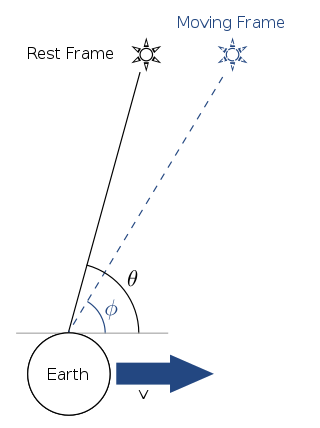
In astronomy, aberration is a phenomenon where celestial objects exhibit an apparent motion about their true positions based on the velocity of the observer: It causes objects to appear to be displaced towards the observer's direction of motion. The change in angle is of the order of where is the speed of light and the velocity of the observer. In the case of "stellar" or "annual" aberration, the apparent position of a star to an observer on Earth varies periodically over the course of a year as the Earth's velocity changes as it revolves around the Sun, by a maximum angle of approximately 20 arcseconds in right ascension or declination.

Barnard's Star is a small red dwarf star in the constellation of Ophiuchus. At a distance of 5.96 light-years (1.83 pc) from Earth, it is the fourth-nearest-known individual star to the Sun after the three components of the Alpha Centauri system, and is the closest star in the northern celestial hemisphere. Its stellar mass is about 16% of the Sun's, and it has 19% of the Sun's diameter. Despite its proximity, the star has a dim apparent visual magnitude of +9.5 and is invisible to the unaided eye; it is much brighter in the infrared than in visible light.

An open cluster is a type of star cluster made of tens to a few thousand stars that were formed from the same giant molecular cloud and have roughly the same age. More than 1,100 open clusters have been discovered within the Milky Way galaxy, and many more are thought to exist. Each one is loosely bound by mutual gravitational attraction and becomes disrupted by close encounters with other clusters and clouds of gas as they orbit the Galactic Center. This can result in a loss of cluster members through internal close encounters and a dispersion into the main body of the galaxy. Open clusters generally survive for a few hundred million years, with the most massive ones surviving for a few billion years. In contrast, the more massive globular clusters of stars exert a stronger gravitational attraction on their members, and can survive for longer. Open clusters have been found only in spiral and irregular galaxies, in which active star formation is occurring.

Proper motion is the astrometric measure of the observed changes in the apparent places of stars or other celestial objects in the sky, as seen from the center of mass of the Solar System, compared to the abstract background of the more distant stars.

Spiral galaxies form a class of galaxy originally described by Edwin Hubble in his 1936 work The Realm of the Nebulae and, as such, form part of the Hubble sequence. Most spiral galaxies consist of a flat, rotating disk containing stars, gas and dust, and a central concentration of stars known as the bulge. These are often surrounded by a much fainter halo of stars, many of which reside in globular clusters.

The radial velocity or line-of-sight velocity of a target with respect to an observer is the rate of change of the vector displacement between the two points. It is formulated as the vector projection of the target-observer relative velocity onto the relative direction or line-of-sight (LOS) connecting the two points.

Hipparcos was a scientific satellite of the European Space Agency (ESA), launched in 1989 and operated until 1993. It was the first space experiment devoted to precision astrometry, the accurate measurement of the positions of celestial objects on the sky. This permitted the first high-precision measurements of the intrinsic brightnesses, proper motions, and parallaxes of stars, enabling better calculations of their distance and tangential velocity. When combined with radial velocity measurements from spectroscopy, astrophysicists were able to finally measure all six quantities needed to determine the motion of stars. The resulting Hipparcos Catalogue, a high-precision catalogue of more than 118,200 stars, was published in 1997. The lower-precision Tycho Catalogue of more than a million stars was published at the same time, while the enhanced Tycho-2 Catalogue of 2.5 million stars was published in 2000. Hipparcos' follow-up mission, Gaia, was launched in 2013.

The Ursa Major Moving Group, also known as Collinder 285 and the Ursa Major association, is the closest stellar moving group – a set of stars with common velocities in space and thought to have a common origin in space and time. In the case of the Ursa Major group, all the stars formed about 300 million years ago. Its core is located roughly 80 light years away and part of the Local Bubble. It is rich in bright stars including most of the stars of the Big Dipper.
6 Andromedae is an astrometric binary star system in the northern constellation of Andromeda. The designation comes from the star catalogue of John Flamsteed, first published in 1712. Its apparent visual magnitude is 5.91, which is just bright enough to be visible to the naked eye under good seeing conditions. Based upon an annual parallax shift of 34.1 mas as seen from Earth, it is around 96 light years from the Sun. It is moving closer to the Sun with a radial velocity of −32.4 km/s. The system has a relatively high proper motion, advancing across the celestial sphere at the rate of 0.272 arc seconds per annum.
54 Cancri is a star in the zodiac constellation of Cancer. It has an apparent visual magnitude of 6.38, which places it just below the normal brightness limit of stars visible to the naked eye. The annual parallax shift is 24.79 mas as measured from Earth's orbit, which yields a distance estimate of about 132 light years. It is moving away from the Sun with a radial velocity of +45 km/s.

Zeta Centauri, Latinized from ζ Centauri, is a binary star system in the southern constellation of Centaurus. It has the proper name Alnair, from Arabic: نير بطن قنطورس, romanized: nayyir baṭan qanṭūris, lit. 'the bright (star) of the body of the centaur'. With a combined apparent visual magnitude of +2.55, it is one of the brighter members of the constellation. This system is close enough to the Earth that its distance can be measured directly using the parallax technique. This yields a value of roughly 382 light-years, with a 1.6% margin of error. It is drifting further away with a radial velocity of +6.5 km/s.

In astronomy, stellar kinematics is the observational study or measurement of the kinematics or motions of stars through space.
26 Draconis is a triple star system in the constellation Draco, located 46 light years from the Sun. Two of the system components, A and B, form a spectroscopic binary that completes an orbit every 76 years. The composite spectral classification of the AB pair is G0V, which decomposes to individual spectral types F9V and K3V. A 1962 study estimated the masses of these two stars as 1.30 and 0.83 times the mass of the Sun, respectively. The stars are considered moderately metal-poor compared to the Sun, which means they have a lower proportion of elements other than hydrogen or helium.
This glossary of astronomy is a list of definitions of terms and concepts relevant to astronomy and cosmology, their sub-disciplines, and related fields. Astronomy is concerned with the study of celestial objects and phenomena that originate outside the atmosphere of Earth. The field of astronomy features an extensive vocabulary and a significant amount of jargon.

Beta Reticuli is binary star system in southern constellation of Reticulum. It is visible to the naked eye with an apparent visual magnitude of +3.84. Based upon an annual parallax shift of 33.49 mas, it is located some 97 light years from our Sun.

Theta Piscis Austrini, Latinized as θ Piscis Austrini, is a binary star system in the southern constellation of Piscis Austrinus. It is faintly visible to the naked eye with a combined apparent visual magnitude of +5.01. Based upon an annual parallax shift of 10.16 mas as seen from the Earth, the system is located around 320 light years from the Sun. The system is drifting further away with a radial velocity of +13 km/s.
HIP 57274 is a star in the northern circumpolar constellation of Ursa Major with a system of three planets. It is invisible to the naked eye, having an apparent visual magnitude of 8.96. The distance to this system is 84.4 light years based on stellar parallax, and it is drifting further away with a radial velocity of +30 km/s. The star has a relatively high rate of proper motion, traversing the celestial sphere at the rate of 0.382 arcsecond/year.
HD 128429 is a binary star system located at a distance of 88 light years from the Sun in the southern zodiac constellation of Libra. It has a yellow-white hue and is just barely visible to the naked eye with an apparent visual magnitude of 6.20. The system is drifting closer to the Sun with a radial velocity of −66 km/s and has a high proper motion, traversing the celestial sphere at the rate of 0.945″ per year. It is a well-known high velocity star system with a net heliocentric velocity of 158.8 km/s. The system is orbiting the through the galaxy with a high eccentricity of 0.62, which carries it from as close as 4.1 out to 17.5 kpc away from the Galactic Center.
HD 217786 is a binary star system in the equatorial constellation of Pisces. With an apparent visual magnitude of 7.78, it requires binoculars or a small telescope to view. The system is located at a distance of 181 light-years from the Sun based on parallax, and is drifting further away with a radial velocity of +10 km/s. Kinematically, the star system belongs to the thin disk population of the Milky Way.

The most important fundamental distance measurements in astronomy come from trigonometric parallax, as applied in the stellar parallax method. As the Earth orbits the Sun, the position of nearby stars will appear to shift slightly against the more distant background. These shifts are angles in an isosceles triangle, with 2 AU making the base leg of the triangle and the distance to the star being the long equal-length legs. The amount of shift is quite small, even for the nearest stars, measuring 1 arcsecond for an object at 1 parsec's distance, and thereafter decreasing in angular amount as the distance increases. Astronomers usually express distances in units of parsecs ; light-years are used in popular media.












